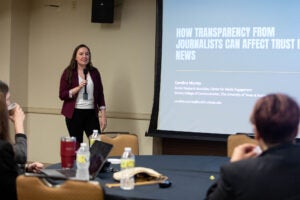April 4, 2022 | Engagement, ISOJ2022, Research, Trust
Four ways news organizations can increase trust and participation with consumers
Members of the Center for Media Engagement (CME) at the University of Texas at Austin presented their research about how to better connect with communities and promote trust with news consumers during a Research Breakfast at the 2022 International Symposium on Online Journalism (ISOJ).
The CME was founded in 2017 in an effort to better understand the media ecosystem and to promote appreciation, trust, and participation in news. In order to do so, the organization researches a variety of topics alongside newsrooms around the world.
Jessica Renee Collier, a postdoctoral research fellow at CME, studied how to encourage re-circulation on news sites. She looked into the different ways news organizations can present links to other reports, including where they’re placed in the stories, how they’re worded, and whether or not images are used. She asked herself: “Once people are on a news site, how can we encourage them to read more news?”

To answer this question, she conducted research with the help of several broadcast news sites and found that news consumers were more likely to continue reading other stories when they’re at the end of the story, have more generic wording, and include pictures. Finding ways to increase participation through links can help bolster engagement on a site, she said.
Meanwhile, Gina Masullo, an associate director of CME, focused on how news organizations can better engage with a subset of their readers, specifically conservatives, who might be more likely to distrust media companies. She found that conservative consumers were concerned about being stereotyped in news and that they wanted more diversity of right-wing voices in journalism.
“They felt like news stories often have a conservative voice that was super extreme,” she said. Masullo quoted one respondee saying, “‘We’re not all driving pickup trucks with a Confederate flag on the back.’”
She suggested that news organizations can start working to bridge that gap by improving diversity in sources and on staff. “Diversity of voices is always a good thing,” Masullo said. One way for news companies to find more diverse conservative voices is by having journalists go out into their communities and spend time with overlooked pockets of voters. In addition, news organizations can put more effort into hiring diverse voices across the political spectrum.
In addition to diversity, she noted that conservatives mentioned they would appreciate more transparency when issuing corrections. However, transparency was an important theme in CME’s research even for new consumers who are not convservative. CME senior research associate Caroline Murray has studied how news organizations can improve trust by implementing transparency cards, or information added to a story about how it was crafted and the steps journalists took to make the reporting fair.
“It gives readers insight into the reporting process,” Murray said.
In her study, Murray required half of the participants to read a story with a transparency card and the other half to read the original story without the extra information. She then interviewed the participants to gauge their responses to the reporting. In the end, she found that there was evidence to suggest participants felt more trust toward news organizations when they included the transparency card.
“Readers do value transparency from journalists and it can help increase their trust in some instances,” Murray said about the cards.
CME director Talia Stroud likewise studied innovative ways to better engage with news consumers in her research on quizzes. Stroud investigated how news consumers feel about quizzes and the best formats for journalists to create them. She studied quizzes on a variety of topics with different formats, including multiple choice and those with images.
“What we see is that it increases time on site, people find it enjoyable, and they learn from it,” she said.
Stroud suggested news organizations create quizzes using a range of formats, including images or a sliding scale, in order to help consumers feel more knowledgeable about tricky topics like politics. She added that quizzes proved to be a good way to correct consumers’ misperceptions about the world.
Journalists can find a quiz-building tool that’s used by more than 500 news organizations on the CME website along with the studies from the research panel.
Sierra Juarez lives in Mexico City and is a freelance reporter and assistant editor at Texas Monthly.

